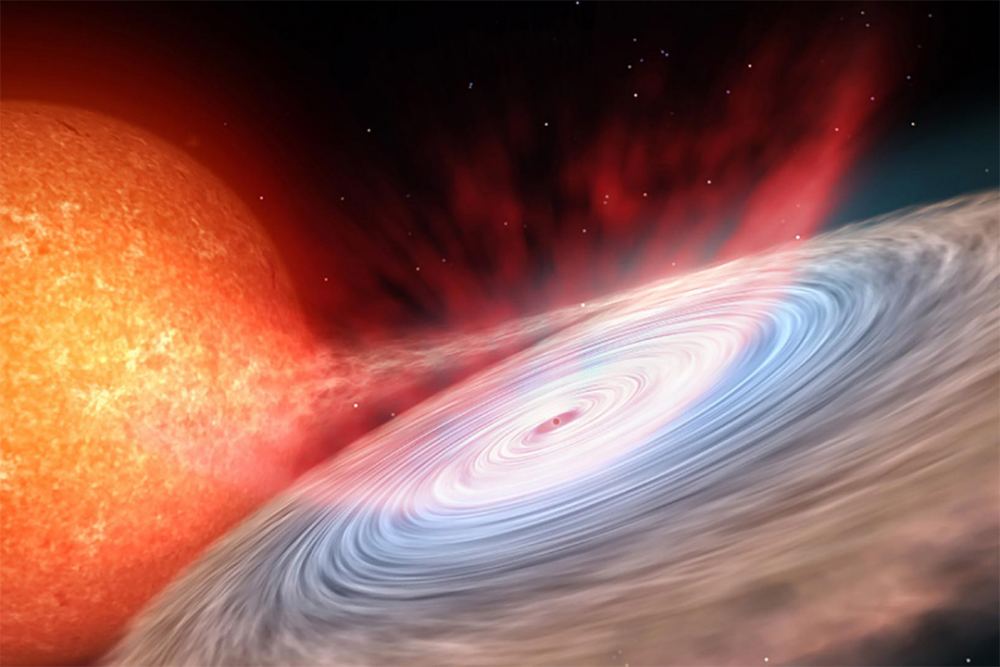The cosmic zoo contains objects so bizarre and extreme that they generate gravitational waves. Scorpius X-1 is part of that strange collection. It’s actually a binary pair: a neutron star orbiting with a low-mass stellar companion called V818 Scorpii. The pair provides a prime target for scientists hunting for so-called “continuous” gravitational waves. Those waves should exist, although none have been detected—yet.

“Scorpius X-1 is one of the most promising sources for detecting these continuous gravitational waves,” said Professor John Whelan from Rochester Institute of Technology’s School of Mathematical Sciences. He’s the principal investigator of RIT’s group in the LIGO Scientific Collaboration, part of a group of scientists focused on the direct detection of gravitational waves. LIGO is the Laser Interferometer Gravitational-Wave Observatory, situated in Washington State and Louisiana. Virgo (in Italy) and KAGRA (in Japan) are also searching for gravitational waves, often in conjunction with LIGO.
Hunting for Gravitational Waves at Scorpius X-1
Whelan’s team used data from the third LIGO-Virgo observing run in their search for continuous gravitational waves from Scorpius X-1. “It’s fairly close at only 9,000 light years away,” said Whelan. “We can see it very brightly in x-rays because the gaseous matter from the companion star is pulled onto the neutron star.”
Despite its brightness, the team did not detect a continuous wash of gravitational waves from Scorpius X-1. That doesn’t mean the waves aren’t there. In fact, their data provide important goalposts as they plan more observations of the pair. It helped them improve their search methodology and should eventually result in the detection of these elusive waves.
“This search yielded the best constraint so far on the possible strength of gravitational waves emitted from Scorpius X-1,” said Jared Wofford, an astrophysical sciences and technology Ph.D. candidate. “For the first time, this search is now sensitive to models of the possible torque balance scenario of the system, which states that the torques of the gravitational wave and accretion of matter onto the neutron star are in balance. In the coming years, we expect better sensitivities from more data taken by Advanced LIGO observing runs probing deeper into the torque balance scenario in hopes to make the first continuous wave detection.”
The Scorpius X-1 System
Scorpius X-1 is the strongest x-ray source in our sky (after the Sun). Astronomers discovered it in 1962 when they sent a sounding rocket with an x-ray detector up to space. Over the years, they figured out that its strong x-ray emissions come from a 1.4-solar mass neutron star that’s gobbling up matter streaming from its smaller 0.4-solar-mass companion. The strong gravitational field of the neutron star accelerates the stellar material as it falls onto the star. That superheats the matter and causes it to give off x-rays.

An artist’s conception of a neutron star shows a schematic of its magnetic field and possible jets of material escaping from the poles. In the Scorpius X-1 system, the neutron star is paired with a low-mass star. Material escapes from the smaller star onto the surface of the neutron star. irregularities in the surface of the neutron star may play a role in creating gravitational waves.Credit: Kevin Gill, Attribution 2.0 Generic (CC BY 2.0)
While the system is a strong x-ray emitter and is bright in optical light, it’s actually classified as a low-mass x-ray binary. The two objects have an 18.9-hour orbital period. It’s not clear if they formed together early in their history. Some astronomers suggest they could have come together when a supermassive star and the small companion had a close encounter in a globular cluster environment. The larger companion eventually exploded as a supernova, which created the neutron star.
Using Gravitational Waves to Understand the Scorpius X-1 Binary Pair
Most of us are familiar with gravitational waves generated by the mergers of black holes and/or neutron stars. The first detection of those waves happened in 2015. Since then, LIGO and its sister facilities KAGRA and Virgo have detected these “stronger” waves regularly. It’s important to remember that those detections record specific collisions—essentially “one-off” events. However, they aren’t the only sources of gravitational waves in the universe. Astronomers think that massive objects that spin hundreds of times per second—such as neutron stars—can produce weaker continuous waves that should be detectable.
So, what might cause the waves in a neutron star/companion star binary pair? Look at the outer structure of neutron stars. Scientists describe them as uniformly smooth objects, with strong gravitational and magnetic fields. However, they could have tiny surface irregularities (called “mountains”). These stick out only fractions of a millimeter above the surface of the neutron star’s “crust”. The mountains are really deformations in that crust. They’re created by extreme stresses in the electromagnetic field of the neutron star.
It’s also possible that these deformities happen as the spin of the object slows down. Or, possibly when its spin suddenly speeds up. However they’re formed, they affect the magnetic and gravitational fields of the neutron star. That may be what’s causing the gravitational waves. If so, those mountains may be small, but their influence could be big.
What’s Next
The challenge now is to measure those waves. Eventually, astronomers will detect a constant “wash” of waves coming from Scorpius X-1. Their data will tell them more about the neutron star itself. It should also give clues to the dynamics of the binary pair as the members orbit with respect to each other.
For More Information
RIT scientists reach a milestone in the search for continuous gravitational wavesModel-based Cross-correlation Search for Gravitational Waves from the Low-mass X-Ray Binary Scorpius X-1 in LIGO O3 DataModelling Neutron Star Mountains in RelativityLigo Scientific Collaboration
Source: www.universetoday.com








